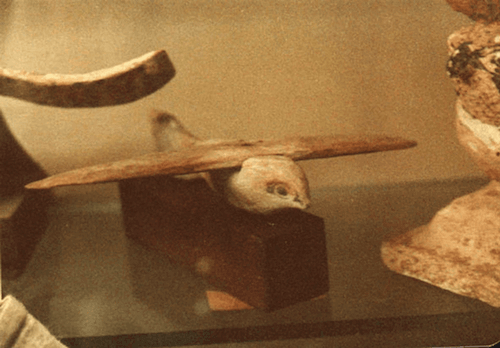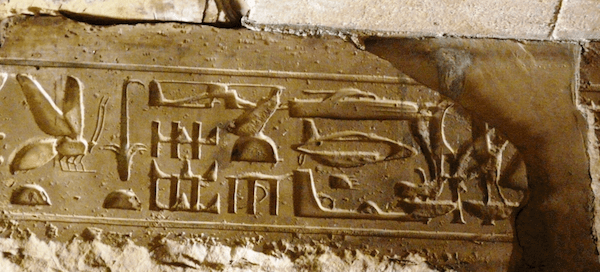Egyptian Artifacts > Saqqara Bird
Saqqara Bird

Background
The Saqqara Bird is an Egyptian artifact that was recovered during the 1898 excavation of the Pa-di-Imen tomb at the Saqqara complex. The artifact is dated to around 200 BCE and is currently in the Museum of Egyptian Antiquities in the modern day city of Cairo
The bird is made of sycamore wood and has a wingspan of 180 mm (7.1 in) and weighs 39.12 g (1.38 oz). While some believe it is a simple ceremonial object, others believe it is evidence that the ancient Egyptians had mastered aviation or at least understood its principles. Others believe it may have been a toy or a type of boomerang.

Saqqara Bird - Museum of Egyptian Antiquities, Cairo
However, using modern technology such as wind-tunnels and flight stimulators, archaeologists are actually proving that the Saqqara Bird could have indeed flown and when a tail stabilizer was added the bird could fly like a modern day fighter jet. So does the lack of evidence of ancient Egyptian gliders or airplanes simply mean we have not found any yet?
Why do we see no hieroglyphs of ancient Egyptians flying yet the depict all sorts of other mundane daily activities. Well the answer to this one may be very simple. The ancient Egyptians had indeed mastered the concepts of aviation and stored them inside this bird. But they gained those principles from studying the birds themselves, not actually trying to make flying airplanes. Until archaeological evidence is found this mystery is still up in the air.
Origins
Religious Icon
Scholars believe the most likely purpose for the Saqqara Bird is a religious icon or figure. The Saqqara Bird is modeled after a falcon and this bird is often used to represent many Egyptian gods such as Horus and Ra Horakhty. This has led many people to believe it is an artifact that was placed on the masthead of their sacred boats during a cultural festival known as the Opet Festival. According to them there are several reliefs in temples throughout Egypt such as at the Temple of Khonsu at the Karnak complex.
This would mean that the bird dates to the late New Kingdom which would put the origins of this bird between 1500 and 1000 BCE. However, the artifact is dated around 200 BCE so they are off by about 800 years. Is there any contemporary evidence of this type of icon being used around 200 BCE?. Or do we need to revise the date that the artifact was made, because one or the other needs to happen.
Once again the scholars provide more questions than they answer, a key sign this may be something more than they say it is.
Throwing Stick
The Egyptians were known to have created throwing sticks similar to boomerangs that could be used to hunt water birds. This proves that the Egyptians knew how to master the technology of this and therefore could have inferred the technology on a toy that could fly properly.
To understand how to create a boomerang you need to understand the principles of aviation and air mechanics. The curve needs to be just right and the wood needs to be perfect as well. So if the ancient Egyptians knew how to make ancient boomerangs, did they also know how to make other things that could fly? Lets find out.
Ancient Aviation Theory
There are some researchers who believe the Saqqara Bird may represent something completely else. The Egyptian physician, archaeologist, parapsychologist and dowser known as Khalil Messiha believes that the artifact is evidence that the Egyptians could have possibly made the first planes, centuries before the principles of aviation were believed to have been discovered.
He believes that the Saqqara Bird is extremely similar to a monoplane and that the bird itself could function as a glider if there was a wooden horizontal tailplane attached. He believes this part of the bird may have been lost over time and suggested that Egyptians created miniature examples of their technology to place in their tombs all the time.
Messiha notes that he compared the Saqqara Bird to all other birds and statues in the Cairo museum but found nothing that is comparable to it. He notes that actually the vertical stabilizer is nothing like the shape of a birds real tail and there are no legs on the artifact. He also believes that since the lower part of the tail is flat it may have been broken and that a tailplane could have actually been attached there.
If you examine the photographs of the Saqqara Bird it can be seen that the tail is flat at the top and that something flat could have easily been placed on top of it, or likewise easily broken off. So was there a tailplane and if so what did it look like? Well Messiha and all the later aviation experts all theorized that the tailplane would form a T with the tail itself.

"Original" Helicopter UFO Hieroglyphs - Temple of Seti I
The wings are also set at such an angle that Messiha believes they are similar to an aircraft in that they would create aerodynamic lift. So if the Egyptians knew how to make airplanes, why weren't they using them in battle and why did we find any of them? Could this be related to the Helicopter UFO Engravings? Well no thats just Ramesses being an ancient vandal.
Messiha's views are not accepted by the archaeological community. Researchers such as Richard Hallion describe the unusual tail as simply being feathers bunched together. He also explains away the aviation theory by suggesting it is too heavy and unstable to fly. So in order to test this theory Messiha built a model of the Saqqara Bird.
Messiha's Model
Messiha built his Saqqara Bird model 6x bigger than the artifact in order to test the proportional aerodynamic effects and see if the flight was possible with a larger craft. He reckoned the object was a scaled model of a real craft so he just scaled it back up to what the Egyptians may have made.
He also added a horizontal tailplane to act as a rear stabilizer, a feature that the original Saqqara Bird did not have. However, Messiha believed this was a missing part and could have easily fallen off in the time it was buried underground. Yet was there a tailplane found in the area where it was discovered? We do not know, maybe it was overlooked if it was a simple piece of wood and is laying mislabeled in a box somewhere. These things are known to happen.
After conducting his experiments Messiha told everyone that the model was a success and was evidence that the Egyptians knew about ancient aviation. So what did leaving aviation experts have to say about this?
Martin Gregorie
Well Martin Gregorie, who builds free flight gliders attempted to recreate Messiha's experiment out of balsa-wood and test its flight capabilities. An expert in free flight gliders, he tested the craft multiple times and he remarked that it never flew and was totally useless without a tail stabilizer. Even with the tail stabilizer the thing flew about as well as a paper airplane and he personally concluded it was a toy or a weather vane.
Well Gregories hypothesis that the Bird is a weathervane is easily proved wrong because there are no holes on the bird. In fact, the only holes or markings on the bird were due to the museum creating the stand as seen in the pictures. The only hole known to exist on the bird was created by the Museum to place the model on a stick for reference. This was documented in the museums records. This means there would be no possible way to hang the bird and place it in a static position.
Simon Sanderson
Yet another aerodynamics expert named Simon Sanderson built a replica of a Saqqara Bird without a tailplane and performed a wind-tunnel experiment to judge the aerodynamic lift capabilities of the artifact. He noted doing a wind-tunnel analysis that the Saqqara Bird actually generated 4x its own weight in lift without the tailplane attached, simply as it stood in the museum.
Studying the bird at Liverpool University, Sanderson then added a tailplane stabilizer and recorded the data. He plotted this data and entered it all into a flight stimulator that would recreate the conditions of a modern fighter jet. Sanderson noted that in the flight stimulator the Saqqara Bird actually flew quite well.
In the virtually created air steams and desert conditions of ancient Egypt the bird was actually able to fly and over 2,000 years ago if the Egyptians had built an aircraft based on this design it would have flown quite well. This is astonishing because it suggests that the ancients had mastered aviation principles so much that they could have theoretically built an airplane that worked.
This is not actually evidence that they did because they could have simply applied those same concepts and theories to the small bird itself. They could have been studying birds and the science behind why they flew. This small bird was the embodiment of the scientific knowledge they gained about flight from studying the animals in their surroundings.
Birds were huge in Egyptian culture and the Egyptians were pretty big on science too. They easily could have had one of their mathematicians figure out the concepts of flight from watching how the local birds flew around for a long time. In fact a lot of scientific discoveries are made simply by observing nature itself.
Conclusion
The fact that the wind-tunnel and flight stimulator experiments proved the Saqqara Bird could have flown in ancient Egyptian conditions is astounding. However, much more research needs to be done in constructing real scale models that could possibly have been the first ancient free gliders in the world.
If we can produce working models and test them using only materials available to ancient Egyptians, then maybe we can prove the Egyptians really did master flight and aviation, possibly creating the first gliders known to man. The problem with this one is also, where would they use them. Unless they were used to traverse dunes or do some ancient base jumping off the Great Pyramid we do not really a practical use for a glider in a desert.
Artifacts
- Amarna Letters
- Annals Of Thutmose III
- Berlin Papyrus
- Brooklyn Papyrus
- Dendera Light Engravings
- Dendera Zodiac
- Djedkhonsuiefankh Funerary Papyrus
- Dream Stele
- Ebers Papyrus
- Edwin Smith Papyrus
- Egyptian Artifacts
- Egyptian Flint Jewelry
- Egyptian Papyri
- El Amra Clay Model Of Cattle
- Great Karnak Inscription
- Great Papyrus Harris
- Kadesh Inscriptions
- Karnak King List
- Khufu Statuette
- Merneptah Stele
- Moscow Mathematical Papyrus
- Nag Hammadi Library
- Narmer Palette
- Oxyrhynchus Papyri
- Palermo Stone
- Pharaonic Tayma Inscription
- Praise Of The Two Lands
- Prisse Papyrus
- Rhind Mathematical Papyrus
- Rosetta Stone
- Saqqara Bird
- Sayala Mace
- Schist Disc
- Scorpion Macehead
- Theurgia Or On The Mysteries Of Egypt
- Tulli Papyrus
- Turin Papyrus
- Tutankahmen Jewel
- Tutankhamuns Meteoric Dagger
- Westcar Papyrus
